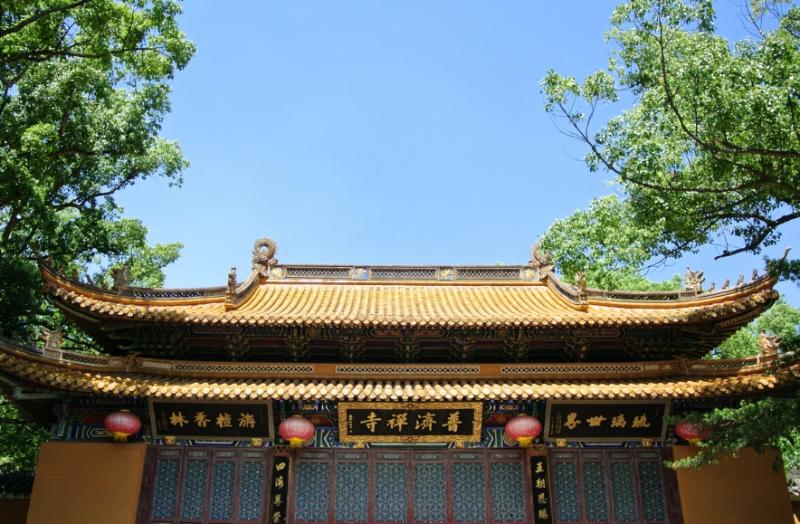Puji Temple

Putuoshan: Puji Temple
Puji Temple, located on Putuoshan Island in the Zhoushan archipelago of Zhejiang Province, is the largest temple on the island and the central temple of Putuoshan, one of the four famous Buddhist mountains in China. It boasts a long history and thriving incense, serving as the bodhimanda of Guanyin Bodhisattva, attracting countless pilgrims to pay homage.
I. Historical Origins
Originating in the Tang Dynasty: According to historical records, the earliest origins of Puji Temple can be traced back to the twenty-sixth year of the Kaiyuan era of the Tang Dynasty (738 AD), when a Japanese monk, Huie, welcomed a statue of Guanyin Bodhisattva from Mount Wutai back to his homeland. On his journey, he encountered a violent storm, forcing his ship to anchor at Putuoshan Island. Huie believed this to be the will of Guanyin Bodhisattva and constructed a temple on the mountain to house the statue of Guanyin, naming it "Unwilling to Leave Guanyin Temple." Puji Temple originated from this.
Reconstruction in the Song Dynasty: During the Song Dynasty, Puji Temple underwent expansion and improvements, and was renamed "Puji Chan Temple." At the time, Puji Temple was grand in scale, with exquisite temple architecture, becoming one of the most important Buddhist temples in Southeast China.
Prosperity in the Ming and Qing Dynasties: During the Ming and Qing dynasties, Puji Temple reached its zenith, expanding in size and becoming more magnificent in its construction, attracting pilgrims and monks from all over China.
II. Architectural Features
Grand Scale: Puji Temple faces south and occupies approximately 30,000 square meters. Its main architectural layout consists of three halls and a courtyard, including the Heavenly Kings Hall, the Great Buddha Hall, the Dharma Hall, and the Guardian Hall. The entire architectural complex is grand and orderly.
Exquisite Carvings: The architectural carvings of Puji Temple are exquisite and renowned for their superb wood, stone, and brick carvings, showcasing the exceptional craftsmanship of ancient Chinese artisans. For instance:
- Four Heavenly Kings Statues in the Heavenly Kings Hall: Lifelike and imposing, they are truly awe-inspiring.
- Coffered Ceiling in the Great Buddha Hall: Using dragon and phoenix motifs, the carvings are intricate and vibrant, offering high aesthetic value.
- Wood-carved Buddha Statues in the Dharma Hall: With gentle brows and serene expressions, they exude the peacefulness of Buddhism.
Ancient Trees Reaching for the Sky: The temple grounds are home to ancient trees that tower over the land, providing shade and adding a touch of tranquility and serenity to the atmosphere. The most renowned among them is the "Thousand-Armed Guanyin Tree," said to bear the image of Thousand-Armed Guanyin on its trunk, one of the wonders of Puji Temple.
III. Cultural Significance
Bodhimanda of Guanyin Bodhisattva: Puji Temple is the bodhimanda of Guanyin Bodhisattva, with thriving incense, attracting pilgrims from all over China to pay homage every year. Believers consider Guanyin Bodhisattva to be compassionate and capable of relieving suffering, thus seeking her blessings for peace and fulfillment of their wishes.
Center of Buddhist Culture: Puji Temple is not only the bodhimanda of Guanyin Bodhisattva but also a significant center of Buddhist culture on Putuoshan Island. The temple houses a vast collection of Buddhist scriptures and artifacts, and regularly hosts various Buddhist events, attracting many Buddhist devotees and cultural scholars for learning and exchange.
Tourist Destination: Puji Temple is not only a Buddhist sacred site but also a famous tourist destination, attracting numerous visitors to explore and experience its charms. Visitors can immerse themselves in the allure of Buddhist culture, appreciate the exquisite architecture of the temple, and witness the unique natural beauty of Putuoshan Island.
IV. Future Prospects
As one of the most important temples on Putuoshan Island, Puji Temple will continue to serve as a center of Buddhist culture and a tourist destination, attracting more pilgrims and visitors, promoting Buddhist culture, and fostering harmonious societal development.
In conclusion, Puji Temple, as the central temple of Putuoshan, boasts a long history, unique architectural style, and rich cultural significance. It is a holy site for Buddhist devotees to pay homage and an excellent choice for tourists seeking cultural experiences. It will continue to uphold Buddhist culture and contribute to harmonious societal development.